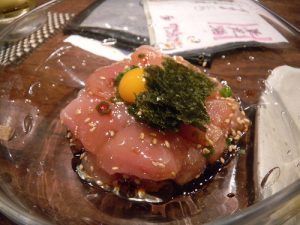Takahiro Takenouchi of The Asahi Shimbun reports that chicken sashimi and “tataki” (seared chicken breasts and livers) are a common menu item in yakitori bars and restaurants across Japan.
 However, eating undercooked or raw chicken can cause food poisoning via the campylobacter bacteria, which can cause severe stomach pain and diarrhea.
However, eating undercooked or raw chicken can cause food poisoning via the campylobacter bacteria, which can cause severe stomach pain and diarrhea.
Raw beef liver and raw pork are banned, but no such restrictions have been imposed on raw chicken, despite many cases of food poisoning caused by eating tainted bird meat.
“It is not fatty, and I love it. I never worry about food poisoning,” said a 39-year-old company employee enjoying a plate of chicken sashimi at a yakitori bar in Tokyo.
The owner of the yakitori bar added, “Chicken sashimi and tataki have been some of our popular dishes since we opened (50 years ago). I am careful about campylobacter.”
The owner said she purchases chickens freshly butchered in the morning for sashimi, and the meat is boiled in hot water until the surface turns white. No cases of food poisoning have ever been reported related to her restaurant.
In June this year, the Ministry of Health, Labor and Welfare finally took action and advised regional public health centers to take steps to implement preventative measures to reduce food poisoning from raw chicken.
Although the advisory is not legally binding, the ministry printed fliers asking restaurants to change their practices.
“Re-evaluate raw and half-raw chicken menus,” the flier reads, urging restaurants to heat the meat at 75 degrees at its core for one minute.
More than 800 people complained about stomachaches or diarrhea in Tokyo and Fukuoka in April and May after eating chicken breast sashimi and chicken sushi rolls at events made by the same company.
 The mass food poisoning in the span of two months prompted the ministry to issue its advisory.
The mass food poisoning in the span of two months prompted the ministry to issue its advisory.
According to ministry preliminary statistics, there were 56 cases with 395 people treated at the hospital for food poisoning from campylobacter from June to August. More than half of the identified causes were due to consuming chicken.
Another ministry report says that 67 percent of chicken meat processed for consumption tested positive for the bacteria, and freshness does not always mean safe.
“There is a certain demand for raw chicken eating, and it is part of our food culture,” a health ministry official said.
The ministry plans to estimate the number of campylobacter infection cases that go unreported to gauge the extent of the food poisoning as it only causes minor diarrhea in some cases. In addition, the ministry seeks to implement sterilizing methods, such as rapid freezing technology or food disinfectants.
“We never expect the public to consume chickens raw,” said Teruaki Oshima with the Japan Chicken Association, which is made up of meat producers and food processing companies. “If consumers choose to eat raw chicken, they should carefully consider the risks, and the level of hygiene and credibility of the restaurant.”
